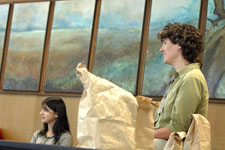
That sentence became known as the “The Graduation Pledge of Social and Environmental Responsibility.” The goal was to get graduating seniors to consider the role they would soon play in making the world a better or worse place. America immediately took notice. The Wall Street Journal, San Francisco Chronicle and San Francisco Examiner all covered the pledge and in just a few short years, the pledge had been adopted at over 30 schools, including Harvard, Stanford and MIT. Today, between 100 and 120 schools are home to the graduation pledge.
Humboldt State recently celebrated the Pledge’s 20th anniversary (October 4th-7th) by dedicating the university’s 2007 Leadership Conference to the pledge. Titled, The Living Pledge, Then and Now the conference attracted well over 100 alumni and students from across the country, and as far away as Taiwan. Many of the pledge’s founders also came to Humboldt State for the four-day conference. The Leadership Conference featured an anniversary reception, recognition awards, service learning projects, musical entertainment and dozens of workshops highlighting environmental and social responsibilities. Key speakers included alumni who have managed to hold fast to their ideals while succeeding as politicians, business leaders and activists.
“The goal of this conference is to inspire people,” says Humboldt State counselor, Chris DeHart. “There’s a whole new generation of students that need to know that they can and should make the world a better place while they’re out there making their career. I know people came away inspired. It was definitely a success.”
LESSON IN A BAG
What’s in those bags?
That was the burning question on the minds of the conference attendees who filed into a classroom at Humboldt State’s Nelson Hall. Four ordinary-looking paper bags stood on a desk at the front of class… And yet there just had to be something special in them, right? After all, this workshop was listed on the conference itinerary as, well, “What’s in the Bag?” Every eye in the room was fixed on those bags. Lorena Boswell, the workshop leader, watched the students seat themselves at four separate tables with a slight smile
Once the students seated themselves, Boswell had a student from each table select a bag without checking its contents. The workshop leader then told the students at each table to construct the longest, most colorful paper chain possible in under five minutes using only the contents within their bag.
The class erupted into a blur of activity as students worked together to complete the task as quickly as possible. It was only, however, at the end of those five minutes that the point of the workshop became clear. That’s when things got interesting. Some of the bags contained tape, colored paper, scissors, staples—everything and anything you might need to succeed. The lucky students with those materials crafted, flowing, colorful “chains” of colored paper. Other bags, however, contained nothing more than scraps of newspaper—not even a single paper clip or smidge of glue. The less fortunate students who opened those bags, not surprisingly, struggled to complete the challenge.
“So what’s going on here?” Lorena Boswell walks around the class prompting the conference attendees.
“Well,” remarks one student, “When I opened my bag, I found all the tape and stuff and I just got busy making this chain. I didn’t even notice that other people didn’t have the tools they needed.”
“That’s funny,” remarked one of the students whose bag had contained few supplies, “I immediately noticed that you guys had plenty of stuff to work with.”
The experiment immediately touched off a long and lively discussion on privilege and poverty in America.
“It’s always the same thing,” explains Boswell after the workshop came to a close. “This simple “What’s in the Bag?” experiment really illustrates the basics about haves and have-nots. It’s a great way to get people thinking about their own lives. If you want to change the world, you need to start by knowing where you fit into the world and the challenges that other people face on a daily basis. I definitely saw light bulbs going off in students heads.”
“It’s not as if we can change the world in a single weekend,” says Leadership Conference Co-Coordinator and Humboldt State senior, Noelle Perlmutter. “But we can get people started on that road. Over one hundred more people are walking away from this conference with a broader world view and a sense that they can make a difference. If those 100 people each go out into the world and spread that mission, it’ll build on itself. That’s a great thing.”
“The pledge is bigger than a single moment during graduation,” says Matt Nicodemus. Nicodemus is one of the original authors of the Pledge and traveled from Taiwan to attend the conference. “There’s that whole rest of your life to live it out. It’s very important for people to feel like they have resources—information and organization—to help support them in that effort. Part of what we’re doing with the conference is reuniting and building a community of people who have made that sort of commitment.”